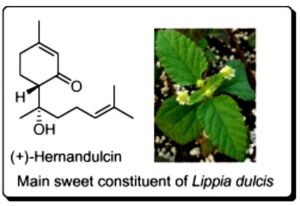What Is Hernandulcin?
Hernandulcin exists naturally as a sesquiterpene-derived secondary terpene, which falls under the bisabolane-type compound classification. Researchers first isolated this compound from Lippia dulcis, which grows naturally in Mexico and Central America. This compound demonstrates extreme sweetness levels reaching 1,000 times that of sucrose but also features a persistent bitter aftertaste. Researchers identified its molecular structure as 6-(1,5-dimethyl-1-hydroxy-4-ene)-3-methylcyclohex-2-enone using both mass spectrometry and nuclear magnetic resonance spectroscopy.
Hernandulcin synthesis begins with farnesyl pyrophosphate (FPP) that enters the sesquiterpene pathway, followed by cyclization, which produces (+)-epi-α-bisabolol. Subsequent oxidation reactions, catalyzed by cytochrome P450 enzymes (CYP450), lead to the final formation of hernandulcin.
Hernandulcin shows great potential as a sweetener, but its intricate synthesis process and minimal natural production rates create obstacles for mass manufacturing. Scientists use metabolic engineering and biotechnological optimization to refine the biosynthetic pathway, which will make hernandulcin commercially viable.
How Is Hernandulcin Used?
Natural Sweetener Alternative
Due to its extreme level of sweetness, hernandulcin stands out as a promising option for substituting sugar. Hernandulcin stands out from artificial sweeteners because it originates naturally and avoids causing dental decay. However, the bitter taste and persistent aftertaste of hernandulcin restrict its direct use within food and drink production sectors. The taste drawbacks of hernandulcin can be reduced through refinement processes or blending with flavor modifiers, which would facilitate more widespread application.
Pharmaceutical Applications
Traditionally, Lippia dulcis, the plant source of hernandulcin, has been utilized in herbal medicine for treating respiratory ailments such as cough and bronchitis. Hernandulcin itself exhibits pharmacological properties, including antispasmodic effects, which may contribute to its medicinal applications. Current research is investigating its capabilities to function as an anti-inflammatory substance and fight against bacteria.
Oral Healthcare Formulations
The non-cariogenic nature of hernandulcin makes it a candidate for inclusion in oral care products such as mouthwashes and dental formulations. This sweetener stands out from typical sweeteners because it prevents tooth decay bacteria from growing, which makes it an excellent component for sugar-free oral care products.
Food and Beverage Flavoring
Hernandulcin belongs to the terpene family and delivers distinctive aromatic characteristics that help improve the taste profiles of different food and drink products. However, its regulatory status and production scalability remain key factors limiting its widespread commercial use.
Cosmetic Industry
The use of terpenes in cosmetics is well established, and hernandulcin’s potential applications in fragrance formulations are under investigation. Its natural origin aligns with the growing demand for botanical-based ingredients in personal care products.
FAQs About Hernandulcin
- What makes hernandulcin different from other natural sweeteners?
Hernandulcin is significantly sweeter than sucrose (1000×) and is structurally distinct from common natural sweeteners like stevia and monk fruit. However, its bitterness and low natural yield limit its immediate use as a commercial sugar substitute.
- Is hernandulcin safe for consumption?
Preliminary toxicological studies indicate that hernandulcin is not acutely toxic and does not exhibit mutagenicity. However, further safety evaluations are needed before regulatory bodies approve its widespread use.
- Can hernandulcin be used in sugar-free products?
Yes. Due to its non-cariogenic properties, hernandulcin is being explored as a sweetening agent in sugar-free formulations, particularly in oral care and pharmaceutical applications.
- Why hasn’t hernandulcin been widely adopted in the food industry?
The primary challenges include its bitterness, low natural production yield, and lack of regulatory approval as a food additive. Ongoing research focuses on improving its taste profile and production scalability.
- Is hernandulcin naturally extracted or synthetically produced?
Hernandulcin is naturally derived from Lippia dulcis. However, due to its low yield in plants, researchers are investigating biotechnological methods, such as microbial fermentation, to enhance its production.







